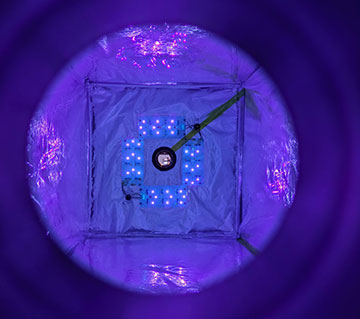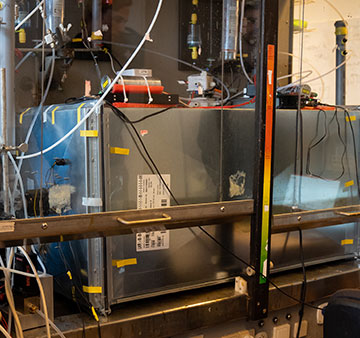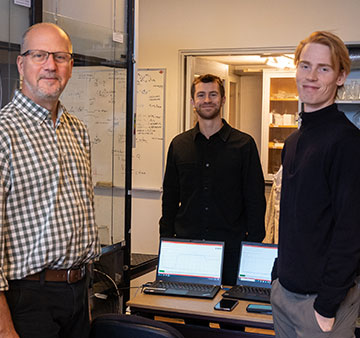
A look inside the MEPS (Methane Eradication Photochemical System) reactor, where chlorine atoms are formed by UV light and react with methane gas. [Image: Morten Krogsbøll]
Carbon dioxide is infamous for being the biggest driver of human-caused global warming, but another, lesser-known greenhouse gas—methane—comes in a close second. According to a report from the Intergovernmental Panel on Climate Change (IPCC), methane has contributed as much as 0.5°C of global warming since pre-industrial times, compared to carbon dioxide’s share of 0.75°C.
While several technologies exist for carbon capture, very few have the ability to remove low concentrations of methane from the air. Now, researchers in Denmark have developed the Methane Eradication Photochemical System (MEPS), which reportedly breaks down methane using a photoreactor that generates chlorine atoms in the gas phase (Environ. Res. Lett., doi: 10.1088/1748-9326/ad0e33). The technology could become a fixture for the control of point source emissions from cattle stalls, wastewater treatment facilities and biogas plants.
Cutting methane at its sources
Since 2021, the IPCC has emphasized the importance of reducing methane emissions to meet the goals of the Paris Agreement—namely, to hold global temperature increase to 1.5°C above pre-industrial levels. Although atmospheric carbon dioxide levels are much higher, methane still poses a danger because it’s incredibly potent as a greenhouse gas. It is about 80 times more powerful than carbon dioxide at trapping heat in Earth’s atmosphere.
An assessment from the United Nations Environment Program estimates that cutting methane emissions by 45% this decade would almost immediately slow the rate of global warming and shave 0.3°C off the increase in global temperature by 2040.
“We are well on our way toward breaking the 1.5°C limit stated in the Paris Agreement. Methane may be our last best hope to avoid crossing important climate tipping points,” said study author Matthew Stanley Johnson, a professor of chemistry at the University of Copenhagen. “Methane stays in the atmosphere for a decade, much shorter than carbon dioxide, so if we can stop its sources, it can be washed out of the atmosphere in the near term.”

The researchers built a reaction chamber and devised a method that simulates and greatly accelerates methane's natural degradation process. [Image: Michael Skov Jensen, SCIENCE/KU]
Methane at higher concentrations can be burned as fuel, but approximately 75% of methane emissions occur at a concentration below 1000 ppm. In addition, the chemical properties of methane make it difficult to capture. Whereas carbon dioxide can be dissolved in water and turned into a salt or mineral, or converted to other products using a catalyst, none of those methods work well for methane.
Generating chlorine with UV light
Previously, Johnson and his colleagues introduced a new method for pollution control called gas-phase advanced oxidation, which uses UV light to generate reactive hydroxyl radicals by photolysis of precursors. The free radicals then break down a target pollutant in the gas phase, generating particles that are removed by a filter. Swapping hydroxyl for chlorine enabled the system to work efficiently for methane.

The research was conducted by Matthew S. Johnson, Hugo Russell and Morten Krogsbøll. [Image: Michael Skov Jensen, SCIENCE/KU]
The MEPS consists of a reaction chamber fitted with 72 UV LEDs with maximum emission at a wavelength of 368 nm, as well as an input tube for adding air, methane and chlorine. The chlorine radicals seek out methane and steal a hydrogen atom from it, leaving it open for reaction with atmospheric oxygen. At the outlet, the air is directed through a wet scrubber to trap the resulting hydrogen chloride. The MEPS then recycles the chlorine and produces a stream of pure hydrogen gas.
A laboratory prototype of the MEPS technology eliminated 58% of methane from air with a concentration of 55 ppm, and since submitting the study, the researchers have further improved the removal efficiency to 88%. “The next step is to scale up and build a field prototype we can take to a biogas plant and a dairy farm,” said Johnson. “We'll build the system in [a full-sized shipping container], do some tests and then take it to meet the cows.”

